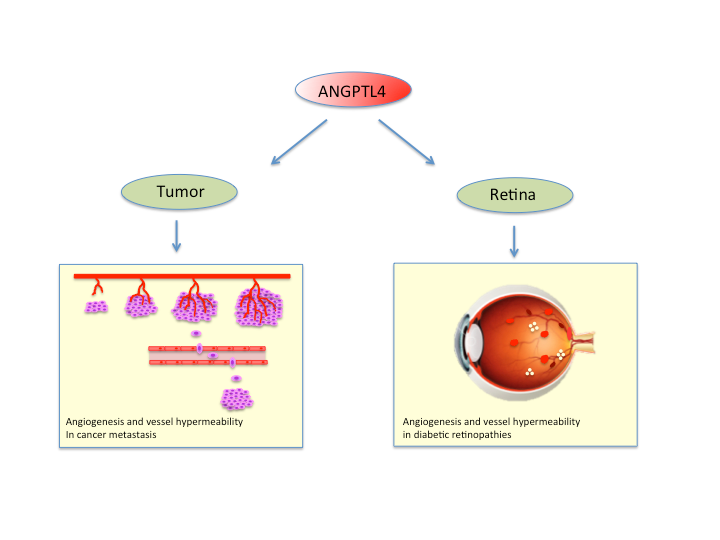contact
Kristen Gale
Program Administrative Specialist
Professor Silvia Montaner, PhD, MPH
 The growth of abnormal blood vessels is a hallmark of human pathology. Therapies targeting the proliferation of atypical blood vessels (pathological angiogenesis) have had an impact on the treatment of many human disorders. My laboratory examines the molecular mechanisms regulating pathological angiogenesis and, in particular, vessel hyperpermeability (leading to “vascular leakiness”). Our lab focuses on two diseases: head and neck cancer and ischemic retinal disease. In cancer, pathological angiogenesis promotes tumor growth as well as dissemination of cancer cells to distal organs (i.e., tumor metastasis). In ischemic retinal disease, damage to the retinal microvasculature triggers the expression of angiogenic factors that promote the formation of new immature and leaky blood vessels in the retina; these abnormal retinal blood vessels can cause profound loss of vision. By studying the molecular mechanism(s) of pathological angiogenesis, our goal is to identify novel molecular targets for the treatment of these diseases.
The growth of abnormal blood vessels is a hallmark of human pathology. Therapies targeting the proliferation of atypical blood vessels (pathological angiogenesis) have had an impact on the treatment of many human disorders. My laboratory examines the molecular mechanisms regulating pathological angiogenesis and, in particular, vessel hyperpermeability (leading to “vascular leakiness”). Our lab focuses on two diseases: head and neck cancer and ischemic retinal disease. In cancer, pathological angiogenesis promotes tumor growth as well as dissemination of cancer cells to distal organs (i.e., tumor metastasis). In ischemic retinal disease, damage to the retinal microvasculature triggers the expression of angiogenic factors that promote the formation of new immature and leaky blood vessels in the retina; these abnormal retinal blood vessels can cause profound loss of vision. By studying the molecular mechanism(s) of pathological angiogenesis, our goal is to identify novel molecular targets for the treatment of these diseases.
In this regard, we have recently identified Angiopoietin-like 4 (ANGPTL4) as a vasoactive molecule that promotes neovascularization and vascular leakage in both cancer and ischemic retinal disease (see publications). ANGPTL4 is a hypoxia-inducible factor (HIF)-regulated factor with close homology to Angiopoietin 1 and Angiopoetin 2(ANGPT1 and ANGPT2), two important proteins in vascular development and angiogenesis. ANGPTL4 is a multifunctional cytokine found in tissues as well as circulating in the bloodstream. Once the protein is translated, it is secreted and then cleaved into two major domains. The ANGPTL4 N-terminal domain (nANGPTL4) is involved in the metabolism of triglycerides and the control of glucose homeostasis and insulin sensitivity. Alternatively, the ANGPTL4 C-terminal domain (cANGPTL4) plays important roles in anoikis resistance, altered redox regulation, angiogenesis, and vascular hyperpermeability.
Our laboratory has described a role for ANGPTL4 as an angiogenic and hyperpermeability factor by inducing endothelial cell migration and endothelial cell junction instability, respectively. Our investigations are focused on the elucidation of the molecular mechanisms responsible for these cellular processes.
